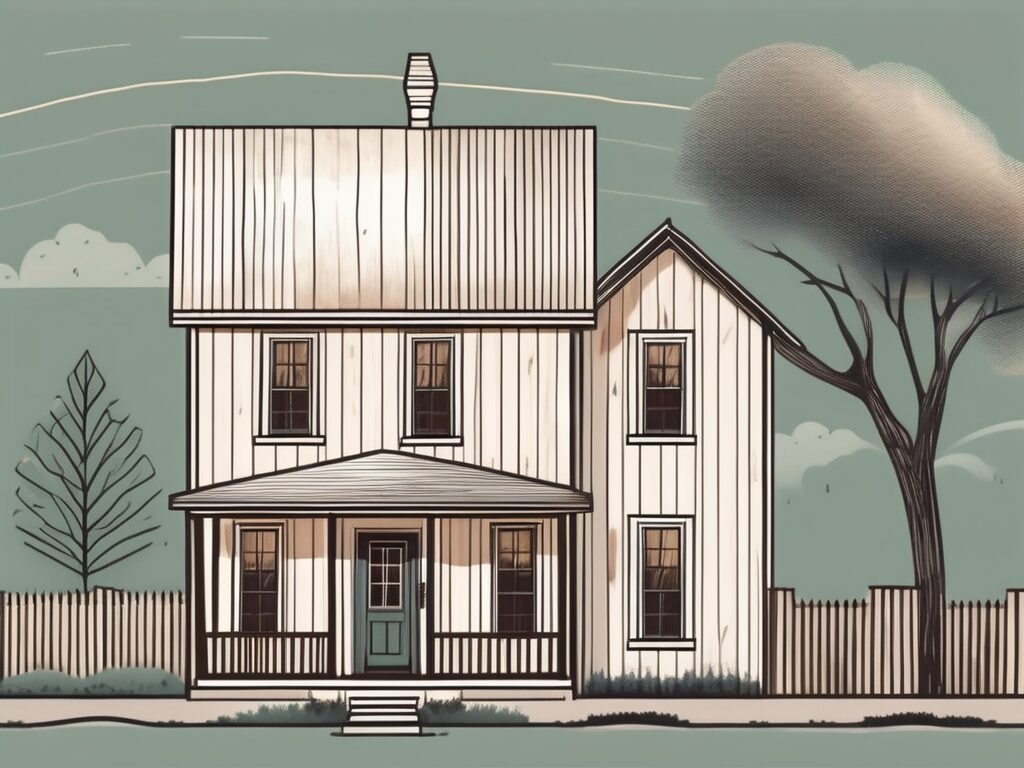
Agent A-Team or Solo Superhero? Finding the Right Real Estate Partner for Your Selling Journey in Wildwood Florida
When it comes to selling your home in Wildwood, Florida,…
January 29, 2024
Saltbox homes are an architectural gem that exudes charm and history. With their distinctive sloping roofs and colonial-era appeal, these houses have a captivating story to tell. In this article, we will delve into the secrets and origins of the saltbox house design, explore iconic examples from history, and discover how these homes have been preserved and renovated to maintain their timeless appeal.
The saltbox house design originated in New England during the 17th century, with its name derived from its resemblance to a wooden box used to store salt. The design’s hallmark feature is its long, sloping roof that extends down to the back of the house, resembling the lid of a saltbox container. This unique roof shape was not only aesthetically pleasing but also practical, as it allowed rain and snow to easily slide off.
The saltbox style was favored by early settlers due to its efficiency and cost-effectiveness. With limited resources, the rear of the house was often built with less expensive materials, while the front showcased more elaborate finishes. This asymmetrical facade added to the charm and character of the saltbox design, making it an architectural standout.
But what about the interior of these fascinating homes? Step inside a traditional saltbox house, and you’ll find a layout that maximizes space and functionality. The front of the house typically housed the main living areas, such as the parlor and dining room, while the back served as storage and workspace. The sloping roof created unique ceiling heights, with the front rooms boasting higher ceilings and the rear rooms having a cozy, intimate feel.
One interesting feature of saltbox houses is the central chimney, which served as the heart of the home. It provided warmth and served as a cooking hearth, with its heat radiating throughout the house. The chimney also acted as a structural support, stabilizing the sloping roof and adding to the overall durability of the house.
Over the years, several iconic saltbox homes have left an indelible mark on American architecture. One such example is the Parson Capen House in Topsfield, Massachusetts. Built in 1683, it remains a testament to the enduring appeal of the saltbox style. Its steeply pitched roof, central chimney, and modest yet elegant exterior are a tribute to the craftsmanship and ingenuity of the era.
Another notable saltbox house is the 1716 Jeremiah Lee Mansion in Marblehead, Massachusetts. Owned by a wealthy colonial merchant, this grand residence showcases the refinement and sophistication that could be achieved within the saltbox framework. Its symmetrical facade, adorned with ornate decorative elements, is a testament to the adaptability of the design.
But what about the stories hidden within the walls of these historic homes? The Parson Capen House, for instance, has witnessed centuries of New England history. Imagine the conversations held within its walls during the tumultuous times of the American Revolution or the joyous celebrations of the early settlers. Each room holds a piece of the past, inviting visitors to step back in time and experience the rich heritage of the saltbox house.
The Jeremiah Lee Mansion, on the other hand, tells a tale of prosperity and ambition. As you walk through its grand halls, you can almost feel the presence of the Lee family, their opulent lifestyle, and their contributions to the development of Marblehead. It serves as a reminder that the saltbox house, with its humble origins, could be transformed into a symbol of wealth and social status.
When it comes to American history and architecture, few styles are as iconic and beloved as the saltbox home. These unique structures, characterized by their sloping roofs and long, sloping backside, have a rich history that dates back to the colonial era. Not only were they practical and functional, but they also exuded a certain charm and elegance that has captivated homeowners and historians alike.
Two of America’s founding fathers, John Adams and John Quincy Adams, were born in saltbox homes. These birthplaces have been meticulously preserved, allowing visitors to step back in time and experience the humble beginnings of these influential figures. The John Adams Birthplace in Quincy, Massachusetts, and the John Quincy Adams Birthplace in Braintree, Massachusetts, embody the historical significance and architectural splendor of saltbox houses.
As you walk through the rooms of these birthplaces, you can’t help but feel a sense of awe and reverence. The creaking wooden floors, the crackling fireplaces, and the simple yet elegant furnishings transport you to a different era. You can almost imagine young John Adams and John Quincy Adams playing in the spacious backyard, their dreams and ambitions taking root in the very place they called home.
Every nook and cranny of these birthplaces tells a story. From the hand-carved wooden beams to the delicate china displayed in the dining room, each detail has been carefully preserved to offer a glimpse into the lives of the Adams family. It’s a testament to the dedication and passion of those who have worked tirelessly to ensure that these historical treasures remain intact for future generations to appreciate.
Nestled in Salisbury, Massachusetts, the Pettengill House stands as a testament to the enduring allure of saltbox homes. Built in the early 18th century, this well-preserved residence offers a glimpse into the lives of the early settlers. With its exposed timbers, low ceilings, and cozy fireplaces, the Pettengill House encapsulates the charm and warmth that these homes are known for.
Stepping into the Pettengill House is like stepping into a time capsule. The air is filled with the scent of aged wood and the faint crackling of a fire. As you explore the various rooms, you can almost hear the echoes of conversations that took place centuries ago. From the kitchen, where hearty meals were prepared, to the bedrooms, where families slept soundly, every corner of the Pettengill House tells a story of resilience and perseverance.
Outside, the sprawling gardens and well-manicured lawns provide a serene backdrop to the historic home. It’s easy to imagine the early settlers tending to their crops and livestock, their hard work and determination shaping the landscape around them. The Pettengill House is a true gem, a testament to the enduring legacy of saltbox homes and the people who called them home.
In addition to individual homes, the Salt Box Museum in Ipswich, Massachusetts, celebrates the rich history of saltbox architecture. This museum provides a comprehensive overview of the design’s evolution, showcasing artifacts, photographs, and interactive exhibits. Visitors can explore the different construction techniques used, learn about the lifestyles of the time, and gain a deeper appreciation for the craftsmanship that went into building these timeless dwellings.
As you wander through the halls of the Salt Box Museum, you’ll be transported through time. The exhibits take you on a journey from the early days of saltbox homes to their modern-day adaptations. You’ll learn about the challenges faced by the early settlers, the materials they used, and the ingenious ways in which they maximized space and functionality.
One particularly fascinating exhibit showcases the various architectural styles influenced by the saltbox design. From Cape Cod cottages to New England farmhouses, the impact of the saltbox style can be seen far and wide. The museum’s collection of photographs and blueprints offers a glimpse into the diverse range of homes that have been inspired by this iconic design.
Whether you’re a history enthusiast, an architecture buff, or simply someone who appreciates the beauty of a well-crafted home, the Salt Box Museum is a must-visit. It’s a place where the past comes alive, where the stories of the people who built and lived in these homes are preserved for generations to come.
Despite the passage of time, saltbox homes continue to captivate homeowners and architectural enthusiasts alike. The lasting appeal of these houses lies in their ability to blend seamlessly with both traditional and contemporary settings. The sloping rooflines, symmetrical facades, and authentic historical details create a sense of timelessness and charm that is hard to resist.
One of the most fascinating aspects of saltbox homes is their rich history. These unique houses originated in New England during the 17th century and were named after their resemblance to a wooden box used to store salt. The design of saltbox homes evolved from the necessity of maximizing space and withstanding the harsh New England winters.
Moreover, the interior layouts of saltbox homes offer a practical and efficient use of space. The steeply pitched roofs allow for generous attic space, which was often used for storage or additional living quarters. The large central chimney, a common feature in these homes, provided warmth and served as a focal point for family gatherings.
Step inside a saltbox home, and you’ll be transported back in time. The rooms are filled with a sense of history and nostalgia, with exposed wooden beams, wide-plank floors, and charming fireplaces. Each nook and cranny tells a story, and the craftsmanship of the past is evident in every detail.
Renovating with Respect: Restoring Saltbox Houses to Their Former Glory
Preserving the historical integrity of saltbox homes is essential when renovating or restoring these architectural treasures. Homeowners and preservationists strive to maintain the original character of the house while incorporating modern amenities and conveniences. Careful attention is paid to architectural details, such as preserving hand-hewn beams, replicating traditional finishes, and utilizing period-appropriate materials.
Restoring a saltbox house is a labor of love. It involves extensive research to ensure that the renovation stays true to the original design and historical context. From sourcing reclaimed materials to hiring skilled craftsmen, every step is taken with utmost care and dedication.
Renovating a saltbox house is not merely about modernization; it is about the preservation of history and the continuation of a timeless legacy. Whether it is restoring a historic saltbox home or building a new one inspired by the design, the allure of these houses remains as strong today as it did centuries ago.
Imagine waking up in a beautifully restored saltbox home, surrounded by the echoes of the past and the comforts of the present. The charm and character of these houses are unmatched, and their enduring appeal is a testament to their timeless design.
As you explore the world of saltbox homes, you’ll discover the stories of the families who lived within their walls, the architectural innovations that shaped their design, and the enduring legacy they have left behind. Whether you are a homeowner looking for a unique and captivating house or an architectural enthusiast fascinated by the history of American homes, saltbox houses are sure to captivate your imagination.
In conclusion, saltbox homes are more than just architectural structures; they are windows into our history and heritage. From their humble beginnings in colonial America to their present-day renewal, saltbox houses continue to captivate and inspire. These unique dwellings embody the charm and elegance of a bygone era while offering practical and timeless living spaces. As we unveil the secrets, explore the history, and admire the enduring charm of saltbox homes, let us appreciate and preserve these architectural treasures for generations to come.

If you want the Richr team to help you save thousands on your home just book a call.
 Book a call
Book a call